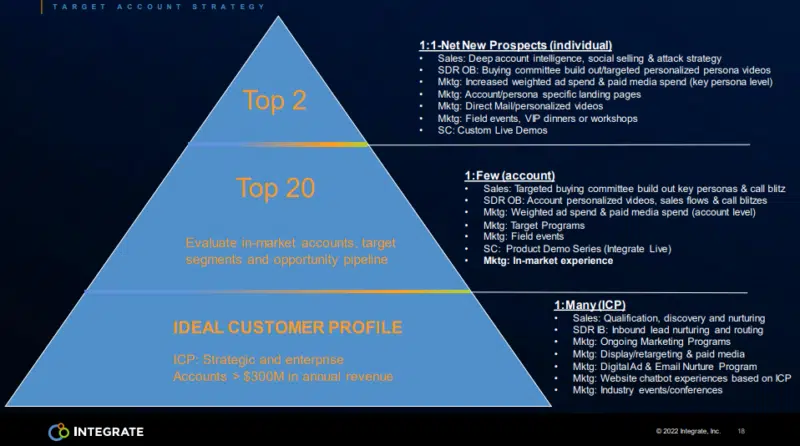How to sharpen your B2B marketing experience strategy
Make sure you’re delivering experiences to buyers with the right level of targeting.
If your customer is a business, there can be multiple decision-makers and influencers within an organization to engage. That’s why many teams implement an account-based marketing (ABM) strategy.
In doing so, marketers need to deliver the experiences and content that are appropriate depending on how advanced the prospect is in the buyer’s journey. This means organizing a strategy around the various levels of engagement that your marketing team reaches with their target.
“It’s our job to make the connections with buyers in the channels that they’re in, and that now requires more digital touchpoints and involves more individuals in the decision-making buying group,” said Stephanie Swinyer, precision marketing company Integrate’s head of revenue marketing, at The MarTech Conference.
First, you need to know how many individuals within the organization that you plan to communicate with for a given message or experience. Then, line these strategies up with actual companies in your target market or region.
3 levels of targeted engagement
Here are three basic levels or flavors of engagement around which you can organize your ABM strategy. Depending on how engaged the prospect is, you will be serving up experiences that are one-to-many, one-to-few, or one-to-one.
Account (one-to-many). Anybody within the organization can be engaged with these experiences. This is early in the organization’s buyer journey, when individuals might be doing their own research on your company’s offerings. They also might be researching your competitors or reading reviews posted by industry peers.
Based on the intent signals generated by these interactions, your team can determine if the account is in-market and looking to buy. They might be searching for prices or showing they’re interested in other ways.
Demand Unit (one-to-few). This is a smaller group within the organization tasked with making key decisions around buying.
“When we’ve determined that an account is in-market, that is the impetus for us to go into that demand unit or buying committee,” said Swinyer.
Instead of passively showing ads on a peer review site, you’ll message these demand unit members on more personalized channels like social media, or invite them to a webinar that gives them more information about your company’s offerings.
Individual (one-to-one). Further down the funnel, your ABM strategy will lead you to key executives with buying authority. The sales team will also be involved with personal calls or meetings. For marketing communications, these messages will be personalized to mirror the one-to-one attention that a live agent provides.
Dig deeper: Why we care about B2B marketing: A guide for marketers
Delivering the right experiences to key accounts
The levels of engagement are shaped like a pyramid, with many experiences delivered one-to-many, and only a handful of one-to-one messages delivered to the key individuals at the very top.
At the bottom of the pyramid, your one-to-many experiences include paid media, display ads, retargeting and emails designed to nurture all prospects within your target market.
“Think of this as your ongoing effort across marketing and sales to qualify, discover and nurture those that fit your ideal customer profile,” said Swinyer.
From these initial engagements across all target accounts, new experiences higher up in the pyramid will be introduced. Because it’s a smaller pot of contacts, more attention and resources will be paid to the way your team engages these higher-value individuals. That’s why one-to-few is the best approach.
“When you get to one-to-few, this is really the account-level,” Swinyer said. “So you’re thinking about the account story you’re telling.”
At this point, marketing is delivering more targeted campaigns and also aligning with sales and their actions, which might include a product demo or call blitz on these key people.
This leads to the key executives at the top of the pyramid, where more data and intelligence will be used to fuel personalization. More paid media can also target these individuals one-to-one.
When your ABM strategy is organized with these distinct tiers of engagement, all of your marketing resources can be spread out efficiently to move buyers through their journey.

Contributing authors are invited to create content for MarTech and are chosen for their expertise and contribution to the martech community. Our contributors work under the oversight of the editorial staff and contributions are checked for quality and relevance to our readers. MarTech is owned by Semrush. Contributor was not asked to make any direct or indirect mentions of Semrush. The opinions they express are their own.
Related stories
New on MarTech